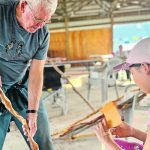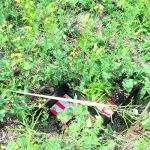New University of Alberta research has found that a healthy population plays an important role in pest management
A study, in its final stages of data analysis, carried out by Carol Frost, an assistant professor of conservation biology at the University of Alberta, is showing the importance of a healthy spider population in pest management.Stories by Freelance writer

Hardy saltwater grass may unlock crop yields
Learning how seashore paspalum grows under stressful conditions may lead to crops that yield more with less fertilizer
Scientists at the University of Nebraska-Lincoln have researched the grass species seashore paspalum’s genome and gene expression to learn how it can grow so efficiently in such stressful conditions. The results offer opportunities to grow crops that yield more food with less fertilizer.
Locally grown goji berries find niche market
Edmonton-area organic market garden has grown the berries for a decade, selling them at farmers markets and food stores
The orange-red oblong berries of the goji plant have an initial sweetness, followed by a bitter aftertaste. They have more than 500 times the amount of vitamin C as an equivalent weight of oranges.
Companies collaborate on intercropping research

Willow converted into walking sticks
A retired Saskatchewan social worker not only transforms the wood into art but also enjoys sharing his craft with others
“Now this is the very best part,” he says excitedly as he holds an old sock in his hand. His 12 students are silent and focused as Greg Mallett runs a white sock dipped in linseed oil along a smoothly sanded willow stick, revealing colours only Mother Nature could create. “Just look at those blacks […] Read more
Six communities find fame on a candy wrapper
Chocolate bar maker selects attractions from communities across Canada to feature on a special edition of KitKats
MONTMARTRE, Sask. — How do you keep a cat in the bag for eight months? Ask Dale Brenner. He’s been on the difficult mission to not let the KitKat out of the bag since September. When the Eiffel Tower in Montmartre was chosen to be one of only six Canadian attractions featured on a special […] Read more
Research underscores microbe value in storing soil carbon

Prairie haskap production sees steady growth
The latest varieties are the second generation developed through the University of Saskatchewan’s breeding program
Most commonly called by its Japanese name, haskap, this berry is also known as honeyberry and sweet berry or blue honeysuckle. It is native to the northern boreal forests in Asia, Europe and North America. Its history can be traced back hundreds of years on Japan’s Hokkaido Island.
Cyclone of 1912 devastated Sask. capital
The twister hit June 30 as residents prepared for Dominion Day, killing 28, injuring 300 and damaging many buildings
The Regina Cyclone remains the worst tornado in Canadian history, 111 years after it occurred. On June 30, 1912, an F4 twister killed 28 people, injured 300 and caused $12,000 in property damage ($30.5 million today) and left 2,500 people homeless. Called a cyclone back then, today it’s classified as a tornado. Cyclone is the […] Read more
Shearers provide vital service for sheep sector
A younger generation is joining the small group of professional shearers who ply their trade across Western Canada
Wrestling a bleating mass of dirty wool weighing more than 200 pounds, flipping it onto its back or side, then wielding an electric shearer — that’s the normal routine for a sheep shearer. “It’s super physical,” said Bethan Lewis, a young shearer from Alexander, Man. All sheep should be shorn once a year to keep […] Read more



